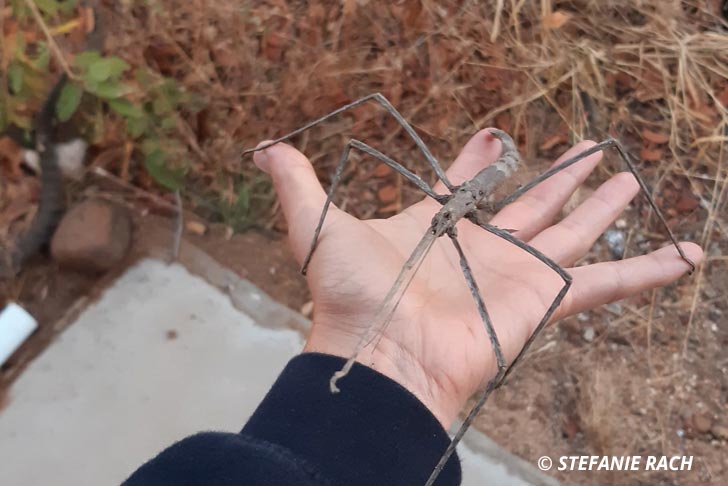Plant Ghosts
As usual, I woke up early in the morning to the pink-golden light of sunrise shining through the mosquito screen of the door. I went outside and there I met – a stick insect. In South Africa there are different kinds of stick insects. The one sitting in the sink outside my chalet was about 15 cm long. Carefully, I slid my hand under it to put it in a bush. Because at least I think stick insects feed on leaves. Do they? Actually: What do I actually know about stick insects? Not much. So I started my research…

By Stefanie Rach
First of all: Yes, stick insects are herbivores. They feed on the leaves of trees and shrubs. Stick insects inhabit the entire planet, except Antarctica. Exactly how many species there are is not known. Currently, about 3,000 species have been described. Some are only 1.5 cm long, others over 60 cm.

Stick insects belong to the order Phasmatodea. The name comes from the ancient Greek “phasma” and means apparition or ghost. This is because all species belonging to the order Phasmatodea look like vegetation, but are actually insects – i.e. a plant appearance or a plant ghost. Some resemble a green leaf, others withered leaves and the stick insect looks like a branch. Some species even have moss- or lichen-like outgrowths, bark-like humps or ridges that resemble leaf veins. In addition, all species of Phasmatodea have a peculiar way of moving: they sway gently from side to side, probably reminiscent of the movement of a leaf or twig in the wind.
Stick insects thus rely mainly on camouflage as defence. But some species can also emit an unpleasant odour, copy ants or scorpions by bending their abdomen over their torso, or have other defence mechanisms.
Stick insects (as well as their close relatives) can clone themselves. In principle, virgin females have the choice between mating and simply reproducing without a male. They lay the unfertilised eggs and a so-called parthenogenesis, a virgin birth, takes place. The nymphs that hatch from the eggs are exact copies of the mother and are all female. However, there is only one way for them to reproduce: parthenogenesis. Offspring from mating-ship, on the other hand, still have the choice between a virgin birth and mating with a male. Such a mating often takes an enormously long time: the record is held by an Indian stick insect species with 79 days.
There are two theories about it: One is that the male wants to make sure he passes on his own genes. In some species, it has been observed that there were fights between males over a female. The already mating male then tried with all his might to keep possible competitors away. Theory number 2 is that the female prefers a longer mating period because she is better protected from predators during this time. The two insects clinging to each other are more difficult to catch. If they also have chemical defences (e.g. secretions or unpleasant odours), a predator is confronted with a double defence. It has also been observed that some females simply use the male as a shield against enemies.
Finally, 2 fun facts about the members of the order Phasmatodea:
1.) The oldest fossil leaf insect found lived in Germany 47 million years ago.
2.) Freshly hatched phasmids have tiny compound eyes with a limited number of facets.
But as the insects grow, the number of facets increases and so does the number of photoreceptor cells. So as these insects get older, they can see better and better in the dark, which is why they switch from daytime to night-time activity.
Every problem has a solution, every solution needs support.
The problems we face are urgent, complicated, and resistant to change. Real solutions demand creativity, hard work, and involvement from people like you.

Stay in the know.
Be ready to act.
To keep up to date with our latest news, events, marches,
campaigns and fundraising activities.
